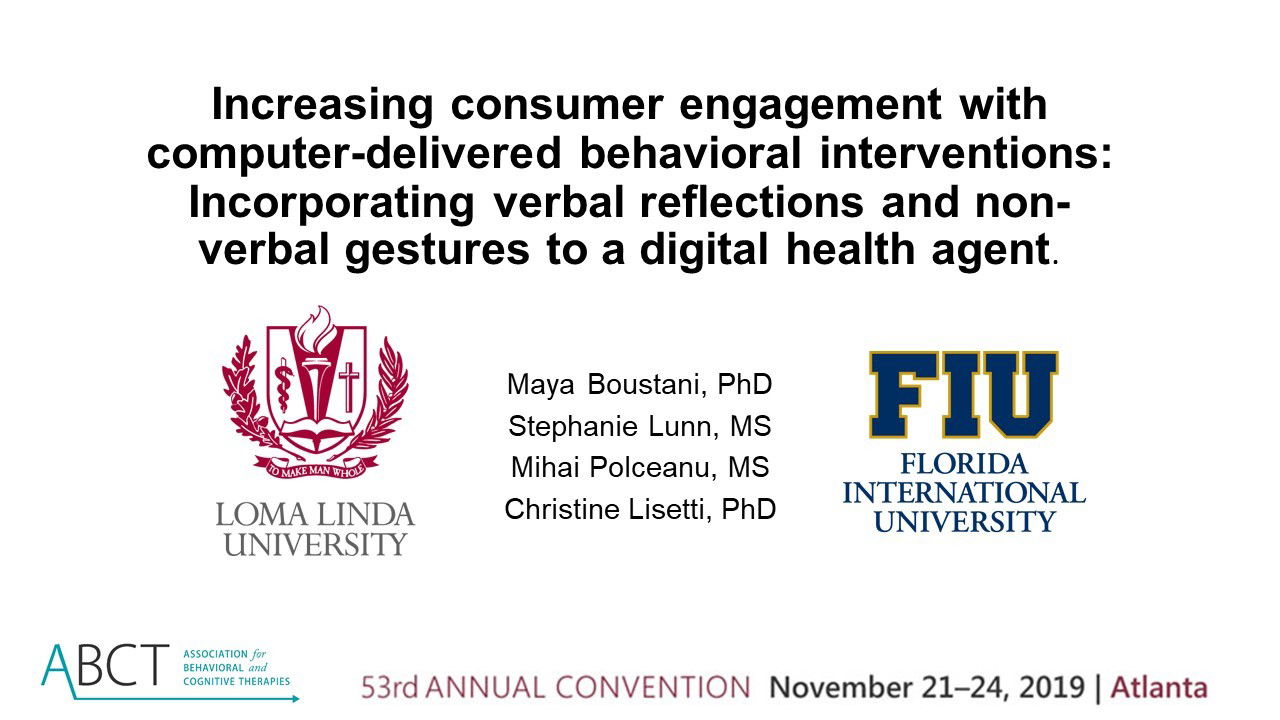Increasing consumer engagement with computer-delivered behavioral interventions: Incorporating verbal reflections and non-verbal gestures to a digital health agent.

Title: Increasing consumer engagement with computer-delivered behavioral interventions: Incorporating verbal reflections and non-verbal gestures to a digital health agent.
Authors:
- Maya Boustani, PhD, Loma Linda University
- Stephanie Lunn, M.S., Florida International University
- Mihai Polceanu, M.S., Ecole Nationale D’Ingenieurs de Brest
- Christine Lisetti, PhD, Florida International University
Keywords:
- Digital health
- Virtual health agent
- Engagement
Abstract Body:
Background: There is a growing need to address the prevalence of behavioral health issues such as obesity, alcohol or drug use. Lack of locally available personnel trained in evidence-based treatments and stigma associated with traditional therapy may limit access. To increase reach, evidence has accumulated about the efficacy of Computer-Delivered Behavioral Interventions (CDBIs) (Rogers et al., 2017). The full success of CDBIs, however, critically relies on ensuring engagement and retention of users. Current CDBIs can be effective, but high attrition rates due to users’ low engagement during the intervention and lack of motivation to use the system, limit their long-term adoption and potential impact (Yeager & Benight, 2018). We describe the process of developing a digital health agent (DHA) that delivers Motivational Interviewing (MI) in an empathetic way, to help increase user engagement.
Method: In order to develop a DHA that is as close as possible to a live counselor delivering MI, we filmed a live counselor delivering MI sessions and coded her verbal reflections and non-verbal behaviors. These codes were the foundation for an initial set of rules to apply to the DHA to make it look more empathetic.
Results: Based on these codes, the current version of the DHA uses a series of non-judgmental verbal reflections such as: “Alright.”, “Sounds Good.”, “Oh, I see.”, “Okay, thanks!”. The DHA also uses nonverbal gestures such as a subtle smile, gaze, hand gestures, body leaning, head gestures, and eyebrow movements.
Conclusion: Unlike other DHAs, incorporating verbal reflections and non-verbal gestures may help increase user engagement and acceptability of the technology, hence reducing attrition from the intervention. We are currently evaluating the perceived acceptability and feasibility of the DHA using a sample of psychology trainees (clinical perspective) and individuals struggling with alcohol abuse (consumer perspective). In addition, efforts to further refine the agent’s verbal responses and non-verbal behaviors using Artificial Intelligence technology is currently under way.



